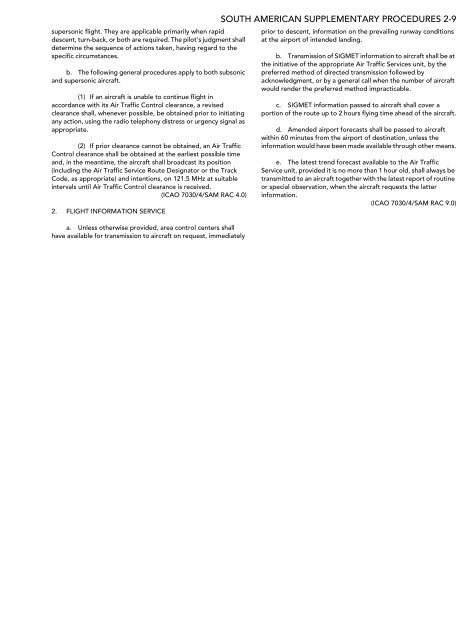NORTH AND SOUTH AMERICA - CNATRA - The US Navy
NORTH AND SOUTH AMERICA - CNATRA - The US Navy
NORTH AND SOUTH AMERICA - CNATRA - The US Navy
You also want an ePaper? Increase the reach of your titles
YUMPU automatically turns print PDFs into web optimized ePapers that Google loves.
supersonic flight. <strong>The</strong>y are applicable primarily when rapid<br />
descent, turn-back, or both are required. <strong>The</strong> pilot's judgment shall<br />
determine the sequence of actions taken, having regard to the<br />
specific circumstances.<br />
b. <strong>The</strong> following general procedures apply to both subsonic<br />
and supersonic aircraft.<br />
(1) If an aircraft is unable to continue flight in<br />
accordance with its Air Traffic Control clearance, a revised<br />
clearance shall, whenever possible, be obtained prior to initiating<br />
any action, using the radio telephony distress or urgency signal as<br />
appropriate.<br />
(2) If prior clearance cannot be obtained, an Air Traffic<br />
Control clearance shall be obtained at the earliest possible time<br />
and, in the meantime, the aircraft shall broadcast its position<br />
(including the Air Traffic Service Route Designator or the Track<br />
Code, as appropriate) and intentions, on 121.5 MHz at suitable<br />
intervals until Air Traffic Control clearance is received.<br />
(ICAO 7030/4/SAM RAC 4.0)<br />
2. FLIGHT INFORMATION SERVICE<br />
a. Unless otherwise provided, area control centers shall<br />
have available for transmission to aircraft on request, immediately<br />
<strong>SOUTH</strong> <strong>AMERICA</strong>N SUPPLEMENTARY PROCEDURES 2-9<br />
prior to descent, information on the prevailing runway conditions<br />
at the airport of intended landing.<br />
b. Transmission of SIGMET information to aircraft shall be at<br />
the initiative of the appropriate Air Traffic Services unit, by the<br />
preferred method of directed transmission followed by<br />
acknowledgment, or by a general call when the number of aircraft<br />
would render the preferred method impracticable.<br />
c. SIGMET information passed to aircraft shall cover a<br />
portion of the route up to 2 hours flying time ahead of the aircraft.<br />
d. Amended airport forecasts shall be passed to aircraft<br />
within 60 minutes from the airport of destination, unless the<br />
information would have been made available through other means.<br />
e. <strong>The</strong> latest trend forecast available to the Air Traffic<br />
Service unit, provided it is no more than 1 hour old, shall always be<br />
transmitted to an aircraft together with the latest report of routine<br />
or special observation, when the aircraft requests the latter<br />
information.<br />
(ICAO 7030/4/SAM RAC 9.0)

















